Implementing Health Warnings on Alcoholic Beverages: On the Leading Role of Countries of the Commonwealth of Independent States
Abstract
1. Introduction
2. Materials and Methods
3. Results
3.1. National and Supranational Regulations of Alcohol Health Warnings in the CIS
3.2. Examples of Health Warnings on Labels of Alcoholic Beverage Containers in the CIS
3.3. The Technical Regulation “On Safety of Alcoholic Beverages” of the Eurasian Economic Union
4. Discussion
5. Conclusions
Author Contributions
Funding
Acknowledgments
Conflicts of Interest
References
- Hepworth, P.; Ward, S.; Schӧlin, L. Alcohol labelling in the global food system: Implications of recent work in the codex committee on food labelling. Eur. J. Risk Regul. 2020. [Google Scholar] [CrossRef]
- Jané-Llopis, E.; Kokole, D.; Neufeld, M.; Hasan, O.S.M.; Rehm, J. What is the Current Alcohol Labelling Practice in the WHO European Region and What are Barriers and Facilitators to Development and Implementation of Alcohol Labelling Policy? WHO Regional Office for Europe: Copenhagen, Denmark, 2020. [Google Scholar]
- Zhao, J.; Stockwell, T.; Vallance, K.; Hobin, E. The effects of alcohol warning labels on population alcohol consumption: An interrupted time series analysis of alcohol sales in Yukon, Canada. J. Stud. Alcohol Drugs 2020, 81, 225–237. [Google Scholar] [CrossRef] [PubMed]
- Vallance, K.; Stockwell, T.; Hammond, D.; Shokar, S.; Schoueri-Mychasiw, N.; Greenfield, T.; McGavock, J.; Zhao, J.; Weerasinghe, A.; Hobin, E. Testing the effectiveness of enhanced alcohol warning labels and modifications resulting from alcohol industry interference in Yukon, Canada: Protocol for a quasi-experimental study. JMIR Res. Protoc. 2020, 9, e16320. [Google Scholar] [CrossRef] [PubMed]
- Vallance, K.; Stockwell, T.; Zhao, J.; Shokar, S.; Schoueri-Mychasiw, N.; Hammond, D.; Greenfield, T.K.; McGavock, J.; Weerasinghe, A.; Hobin, E. Baseline assessment of alcohol-related knowledge of and support for alcohol warning labels among alcohol consumers in northern Canada and associations with key sociodemographic characteristics. J. Stud. Alcohol Drugs 2020, 81, 238–248. [Google Scholar] [CrossRef]
- World Health Organization. WHO Report on the Global Tobacco Epidemic 2019: Offer Help to Quit Tobacco Use. Available online: https://apps.who.int/iris/bitstream/handle/10665/332129/9789289054898-eng.pdf (accessed on 25 September 2020).
- Chung-Hall, J.; Craig, L.; Gravely, S.; Sansone, N.; Fong, G.T. Impact of the WHO FCTC over the first decade: A global evidence review prepared for the Impact Assessment Expert Group. Tob. Control 2019, 28, s119–s128. [Google Scholar] [CrossRef] [PubMed]
- King, J.L.; Reboussin, B.A.; Cornacchione Ross, J.; Sutfin, E.L. Waterpipe tobacco package warning exposure’s impact on risk perceptions and use among young adults in the USA: A longitudinal analysis of the population assessment of tobacco and health study. Tob. Control 2019, 28, e16–e23. [Google Scholar] [CrossRef] [PubMed]
- Levy, D.T.; Tam, J.; Kuo, C.; Fong, G.T.; Chaloupka, F. The impact of implementing tobacco control policies: The 2017 tobacco control policy scorecard. J. Public Health Manag. Pract. 2018, 24, 448–457. [Google Scholar] [CrossRef] [PubMed]
- Noar, S.M.; Hall, M.G.; Francis, D.B.; Ribisl, K.M.; Pepper, J.K.; Brewer, N.T. Pictorial cigarette pack warnings: A meta-analysis of experimental studies. Tob. Control 2016, 25, 341–354. [Google Scholar] [CrossRef] [PubMed]
- Noar, S.M.; Francis, D.B.; Bridges, C.; Sontag, J.M.; Ribisl, K.M.; Brewer, N.T. The impact of strengthening cigarette pack warnings: Systematic review of longitudinal observational studies. Soc. Sci. Med. 2016, 164, 118–129. [Google Scholar] [CrossRef] [PubMed]
- Cogliano, V.J.; Baan, R.; Straif, K.; Grosse, Y.; Lauby-Secretan, B.; El Ghissassi, F.; Bouvard, V.; Benbrahim-Tallaa, L.; Guha, N.; Freeman, C.; et al. Preventable exposures associated with human cancers. J. Natl. Cancer Inst. 2011, 103, 1827–1839. [Google Scholar] [CrossRef] [PubMed]
- Winstock, A.R.; Holmes, J.; Ferris, J.A.; Davies, E.L. Perceptions of alcohol health warning labels in a large international cross-sectional survey of people who drink alcohol. Alcohol Alcohol. 2020, 55, 315–322. [Google Scholar] [CrossRef] [PubMed]
- Weerasinghe, A.; Schoueri-Mychasiw, N.; Vallance, K.; Stockwell, T.; Hammond, D.; McGavock, J.; Greenfield, T.K.; Paradis, C.; Hobin, E. Improving knowledge that alcohol can cause cancer is associated with consumer support for alcohol policies: Findings from a real-world alcohol labelling study. Int. J. Environ. Res. Public Health 2020, 17, 398. [Google Scholar] [CrossRef] [PubMed]
- Stockwell, T.; Robert Solomon, L.M.; O’Brien, P.; Vallance, K.; Hobin, E. Cancer warning labels on alcohol containers: A consumer’s right to know, a government’s responsibility to inform, and an industry’s power to thwart. J. Stud. Alcohol Drugs 2020, 81, 284–292. [Google Scholar] [CrossRef] [PubMed]
- World Health Organization Regional Office for Europe. Alcohol Labelling. A Discussion Document on Policy Options. Available online: https://www.euro.who.int/__data/assets/pdf_file/0006/343806/WH07_Alcohol_Labelling_full_v3.pdf (accessed on 26 September 2020).
- Base.Spinform.ru. Baza Dannyh “Zakonodatel’stvo Stran SNG”. [Database “CIS Legislation”]. Available online: http://base.spinform.ru/index.fwx (accessed on 30 September 2020).
- Geography Agency. Reklamnoe Agentstvo «Geografija. Reklama v Regionah» Rabotaem po Vsemu SNG. [Advertising Agency “Geography”. Advertising in the Regions »We Work all over the CIS]. Available online: https://geography.agency/ (accessed on 26 September 2020).
- World Health Organization Regional Office for Europe. Implementing Alcohol Policies in the Commonwealth of Independent States. A Workshop of “First-Mover” Countries; World Health Organization Regional Office for Europe: Copenhagen, Denmark, 2020. [Google Scholar]
- Eurasian Economic Commission. Evrazijskij Jekonomicheskij Sojuz. [Eurasian Economic Union]. Available online: http://www.eaeunion.org/#resources (accessed on 25 September 2020).
- Rehm, J.; Kailasapillai, S.; Larsen, E.; Rehm, M.X.; Samokhvalov, A.V.; Shield, K.D.; Roerecke, M.; Lachenmeier, D.W. A systematic review of the epidemiology of unrecorded alcohol consumption and the chemical composition of unrecorded alcohol. Addiction 2014, 109, 880–893. [Google Scholar] [CrossRef] [PubMed]
- Eurasian Economic Commission. O Tehnicheskom Reglamente Evrazijskogo Sojuza “O Bezopasnosti Alkogol’noj Produkcii”. [On the Technical Regulation of the Eurasian Union “On the Safety of Alcoholic Beverages]. Available online: https://docs.eaeunion.org/docs/ru-ru/01421305/cncd_10122018 (accessed on 25 September 2020).
- Novotest.ru. Tehnicheskij Reglament Evrazijskogo Jekonomicheskogo Sojuza “O Bezopasnosti Alkogol’noj Produkcii” (TR EAJeS 047/2018). [Technical Regulation of the Eurasian Economic Union “On the Safety of Alcoholic Beverages” (TR EAEU 047/2018)]. Available online: https://www.novotest.ru/tr-ts/047-2018/tr-ts-047-2018.pdf (accessed on 25 September 2020).
- Ministry of Health of the Republic of Belarus. Pis’mo “Po Voprosu Razmeshhenija na Jetiketkah i v Reklame Alkogol’nyh Napitkov i Piva Frazy Upotreblenie Alkogolja Vredit Zdorov’ju”. [Letter “On the Issue of Placing on the Labels and in Advertising of Alcoholic Beverages and Beer the Phrase” Alcohol Consumption is Harmful to Health”]. Available online: http://minzdrav.gov.by/upload/lcfiles/%D0%B1%D0%BD.pdf (accessed on 30 September 2020).
- Ministry of Justice of the Republic of Kazakhstan. Ob Utverzhdenii Tehnicheskogo Reglamenta “Trebovanija k Bezopasnosti Alkogol’noj Produkcii” (Izmenenija na 20 Oktjabrja 2010). [On the Approval of the Technical Regulation “Requirements for the Safety of Alcoholic Beverages” (Changes as of October 20, 2010)]. Available online: https://tengrinews.kz/zakon/pravitelstvo_respubliki_kazahstan_premer_ministr_rk/topgovlya_i_obschestvennoe_pitanie/id-P1000001081/ (accessed on 30 September 2020).
- Base.Spinform.ru. Zakon Respubliki Moldova ot 30 Ijunja 2000 Goda №1100-XIV. O Proizvodstve i Oborote Jetilovogo Spirta i Alkogol’noj Produkcii. [Law of the Republic of Moldova of June 30, 2000 No. 1100-XIV. On the Production and Circulation of Ethyl Alcohol and Alcoholic Beverages]. Available online: https://base.spinform.ru/show_doc.fwx?rgn=3409 (accessed on 30 September 2020).
- Rg.ru. Prikaz Ministerstva Zdravoohranenija i Social’nogo Razvitija Rossijskoj Federacii (Minzdravsocrazvitija Rossii) ot 19 Janvarja 2007 g. N 49 g, Moskva Ob Utverzhdenii Preduprezhdajushhej Nadpisi na Potrebitel’skoj Tare Edinicy Alkogol’noj Produkcii o Protivopokazanijah k Upotrebleniju Alkogol’noj Produkcii. [Order of the Ministry of Health and Social Development of the Russian Federation (Ministry of Health and Social Development of Russia) of January 19, 2007 N 49, Moscow On the Approval of a Warning Inscription on the Consumer Container of a Unit of Alcoholic Beverages on Contraindications to the Use of Alcoholic Beverages. Available online: https://rg.ru/2007/02/02/alkogol-etiketka-dok.html (accessed on 30 September 2020).
- Ministry of Health of Turkmenistan. Zakon Turkmenistana O Profilaktike Vrednogo Vozdejstvija Alkogolja. [Law of Turkmenistan on the Prevention of the Harmful Effects of Alcohol]. Available online: http://minjust.gov.tm/mcenter-single-ru/44 (accessed on 30 September 2020).
- Base.spinform.ru. Prikaz General’nogo Direktora Uzbekskogo Agentstva Standartizacii, Metrologii i Sertifikacii ot 1 Ijunja 2016 Goda №315. O Vnesenii Izmenenij v Porjadok Markirovanija Znakom Sootvetstvija Alkogol’noj Produkcii, Vypuskaemoj Predprijatijami na Territorii Respubliki Uzbekistan. [Order of the Director General of the Uzbek Agency for Standardization, Metrology and Certification Dated June 1, 2016 No. 315. On Amendments to the Procedure for Marking with the Conformity Mark of Alcoholic Beverages Produced by Enterprises on the Territory of the Republic of Uzbekistan]. Available online: http://base.spinform.ru/show_doc.fwx?rgn=86878 (accessed on 30 September 2020).
- Files.stroyinf.ru; Biblioteka Tehnicheskoj Dokumentacii. Tehnicheskij Reglament O Bezopasnosti Alkogol’noj Produkcii. Proekt. [Library of Technical Documentation. Technical Regulations On the Safety of Alcoholic Beverages. Project]. Available online: https://files.stroyinf.ru/Data2/1/4293799/4293799316.pdf (accessed on 26 September 2020).
- Gricjuk, M.; Butylka s Preduprezhdeniem. Nadpis’ o Vrede Alkogolja Mozhet Pojavit’sja Na Ego Jetiketkah. [A Warning Bottle. A Warning about the Dangers of Alcohol may Appear on its Labels.]. Available online: https://rg.ru/2011/04/05/alkogol-site.html (accessed on 25 September 2020).
- Ministry of Economic Development of the Russian Federation. Zakljuchenie ob Ocenke Regulirujushhego Vozdejstvija na Proekt Postanovlenija Pravitel’stva Rossijskoj Federacii «Ob Utverzhdenii Tehnicheskogo Reglamenta o Bezopasnosti Alkogol’noj Produkcii». [Conclisionon the Assessment of the Regulatory Impact on the Draft Decree of the Government of the Russian Federation “On Approval of Technical Regulations on the Safety of Alcoholic Beverages”]. Available online: http://old.economy.gov.ru/minec/about/structure/depRegulatingInfluence/doc20110530_08?presentationtemplateid=2dd7bc8044687de796f0f7af753c8a7e. (accessed on 25 September 2020).
- Business-gazeta.ru. O Vrede Alkogolja Vskore Zajmet ne Menee 20% Jetiketki Butylok Podrobnee na «BIZNES Online». [The Message about the Dangers of Alcohol will soon Take up at least 20% of the Bottle Label]. Available online: https://www.business-gazeta.ru/news/38449 (accessed on 25 September 2020).
- Eurasian Economic Commission. Proekt Tehnicheskij Reglament Tamozhennogo Sojuza o “O Bezopasnosti Alkogol’noj Produkcii”. [Draft Technical Regulations of the Customs Union on “On the Safety of Alcoholic Beverages”]. Available online: http://www.eurasiancommission.org/ru/act/texnreg/deptexreg/tr/Documents/%D0%A2%D0%A0%20%D0%A2%D0%A1%20%D0%90%D0%BB%D0%BA%D0%BE%D0%B3%D0%BE%D0%BB%D1%8C%20%D0%92%D0%93%D0%A1.pdf (accessed on 25 September 2020).
- World Trade Organization. Minutes of the Meeting. Available online: https://docs.wto.org/dol2fe/Pages/FE_Search/FE_S_S009-DP.aspx?language=E&CatalogueIdList=134466,132661,132294,%20130728,130294&CurrentCatalogueIdIndex=2&FullTextHash=&HasEnglishRecord=True&Has%20FrenchRecord=%20True&HasSpanishRecord=True (accessed on 25 September 2020).
- World Health Organization. Global Status Report on Alcohol and Health 2018; World Health Organization: Geneva, Switzerland, 2018. [Google Scholar]
- Babor, T.F.; Jernigan, D.; Brookes, C. The regulation of alcohol marketing: From research to public health policy. Addiction 2017, 112, 1–127. [Google Scholar]
- Babor, T.F.; Jernigan, D.; Brookes, C.; Brown, K. Toward a public health approach to the protection of vulnerable populations from the harmful effects of alcohol marketing. Addiction 2017, 112, 125–127. [Google Scholar] [CrossRef]
- Pan American Health Organization. PAHO Meeting on Alcohol Marketing Regulation: Final Report. Available online: https://iris.paho.org/bitstream/handle/10665.2/28424/PAHONMH16001_eng.pdf?sequence=1&isAllowed=y (accessed on 26 September 2020).
- MacKinnon, D.P.; Lapin, A. Effects of alcohol warnings and advertisements: A test of the boomerang hypothesis. Psychol. Mark. 1998, 15, 707–726. [Google Scholar] [CrossRef]
- World Health Organization Regional Office for Europe. Implementing Alcohol Policies in the Commonwealth of Independent States. A Workshop of “First-Mover” Countries. Available online: https://apps.who.int/iris/handle/10665/335946 (accessed on 30 September 2020).
- Neufeld, M.; Bobrova, A.; Davletov, K.; Štelemėkas, M.; Stoppel, R.; Ferreira-Borges, C.; Breda, J.; Rehm, J. Alcohol control policies in Former Soviet Union countries—A narrative review of a series of natural experiments in implementing the “best buys”. Drug Alcohol Rev. 2020. in print. [Google Scholar] [CrossRef]
- World Health Organization Regional Office for Europe. Alcohol Policy Impact Case Study; The Effects of Alcohol Control Measures on Mortality and Life Expectancy in the Russian Federation; WHO Regional Office for Europe: Copenhagen, Denmark, 2019. [Google Scholar]
- Sputniknews.ru. Zapivat’ Problemy: Otpugnut li “Strashilki” na Butylkah Ljubitelej Spirtnogo. [Wash down Problems: Will “Horror Stories” on Bottles Scare away Alcohol Lovers]. Available online: https://az.sputniknews.ru/life/20180831/416819778/vino-vodka-azerbaijan.html (accessed on 25 September 2020).
- FOR.kg. Minzdrav Preduprezhdaet. Na Butylkah s Alkogolem Pojavjatsja Strashnye Kartinki. [The Ministry of Health Warns. Scary Pictures will Appear on Alcohol Bottles]. Available online: https://www.for.kg/news-534636-ru.html (accessed on 25 September 2020).
- Perceva, E. Gradus i Preduprezhdenie: FAS za Pugajushhuju Nadpis’ na Butylkah Spirtnogo No Ustrashajushhie Kartinki na Jetiketkah—Jeto Lishnee, Schitajut v Antimonopol’noj Sluzhbe. [Degree and Warning: FAS for a Frightening Inscription on Alcohol Bottles, But Frightening Pictures on Labels are Superfluous, According to the Antimonopoly Service]. Available online: https://iz.ru/818698/evgeniia-pertceva/gradus-i-preduprezhdenie-fas-za-pugaiushchuiu-nadpis-na-butylkakh-spirtnogo (accessed on 25 September 2020).
- Balashova, T.N.; Bonnjeer, B.; Isurina, G.L.; Regentova, A.J.; Cvetkova, L.A. Izuchenie vlijanija informacionnyh materialov na otnoshenie zhenshhin k upotrebleniju alkogolja vo vremja beremennosti. [Study of the influence of information materials on women’s attitudes towards alcohol consumption during pregnancy] Vestnik Sankt-Peterburgskogo Universiteta. Ser. 12 Sociol. 2012, 4, 101–108. [Google Scholar]
- Zhmurov, D.V. Profilaktika upotreblenija alkogolja za rulem transportnyh sredstv. [Prevention of alcohol consumption while driving]. Baikal Res. J. 2018, 9. [Google Scholar] [CrossRef]
- Somenkov, S.A. Osobennosti reklamy alkogol’noj produkcii, piva i tabachnyh izdelij. [Features of advertising of alcoholic beverages, beer and tobacco products]. Zakony Ross. Opyt. Anal. Prakt. 2009, 10, 28–35. [Google Scholar]
- Belokobyl’skaja, O.I.; Katkov, S.V. Aktual’nye problemy raskrytija i rassledovanija roznichnoj prodazhi alkogol’noj produkcii nesovershennoletnim. [Current problems of disclosure and investigation of retail sale of alcoholic beverages to minors.]. Vestn. Volgogr. Akad. Mvd. Ross. 2018, 4, 69–74. [Google Scholar]
- World Trade Organization. Notification G/TBT/N/THA/332 (Dated 21 January 2010) “Draft notification of the Alcohol Beverage Control, Re: Criteria, Procedures and Requirements for Alcohol Beverage Packages or Pictorial Labels/Warning Statements on the Local Manufactured or Imported Alcohol Beverage”. Available online: https://docs.wto.org/dol2fe/Pages/FE_Search/FE_S_S009-DP.aspx?language=E&CatalogueIdList=131759,123608&CurrentCatalogueIdIndex=1&FullTextHash=1&HasEnglishRecord=True&HasFrenchRecord=True&HasSpanishRecord=True (accessed on 30 October 2020).
- World Trade Organization. Technical Barriers to Trade Information Management System. Regular Notification G/TBT/N/THA/332. Available online: https://www.wto.org/english/tratop_e/tbt_e/tbt_e.htm (accessed on 30 September 2020).
- European Commission. Non-communicable Diseases. Cancer. Available online: https://ec.europa.eu/health/non_communicable_diseases/cancer_e (accessed on 30 September 2020).
- O’Brien, P.; Mitchell, A.D. On the Bottle: Health Information, Alcohol Labelling and the WTO Technical Barriers to Trade Agreement. QUT Law Review 2018, 18, 1–32. Available online: http://dx.doi.org/10.2139/ssrn.3166690 (accessed on 30 September 2020). [CrossRef]
- O’Brien, P. Australia’s double standard on Thailand’s alcohol warning labels. Drug Alcohol Rev. 2013, 32, 5–10. [Google Scholar] [CrossRef]
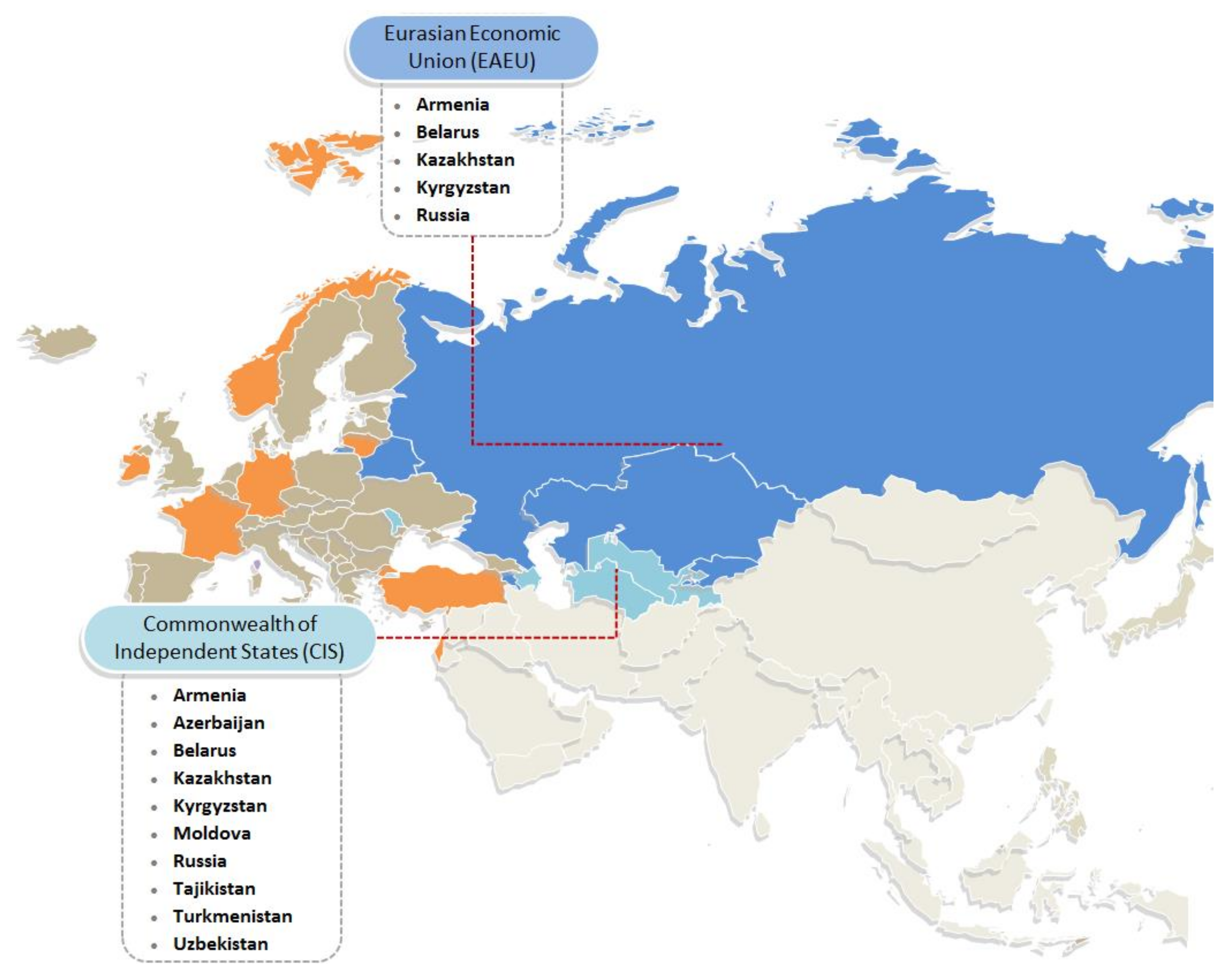
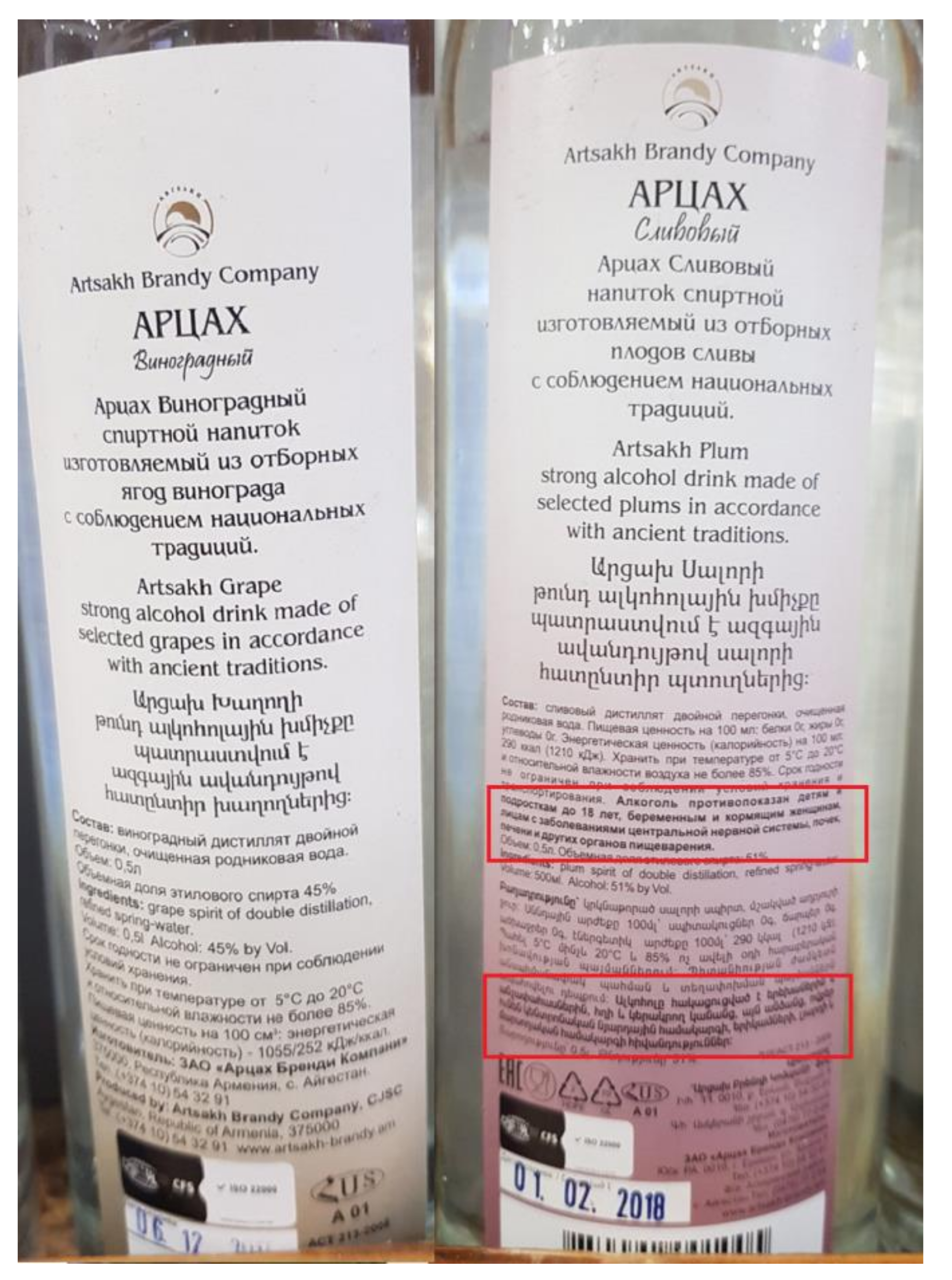
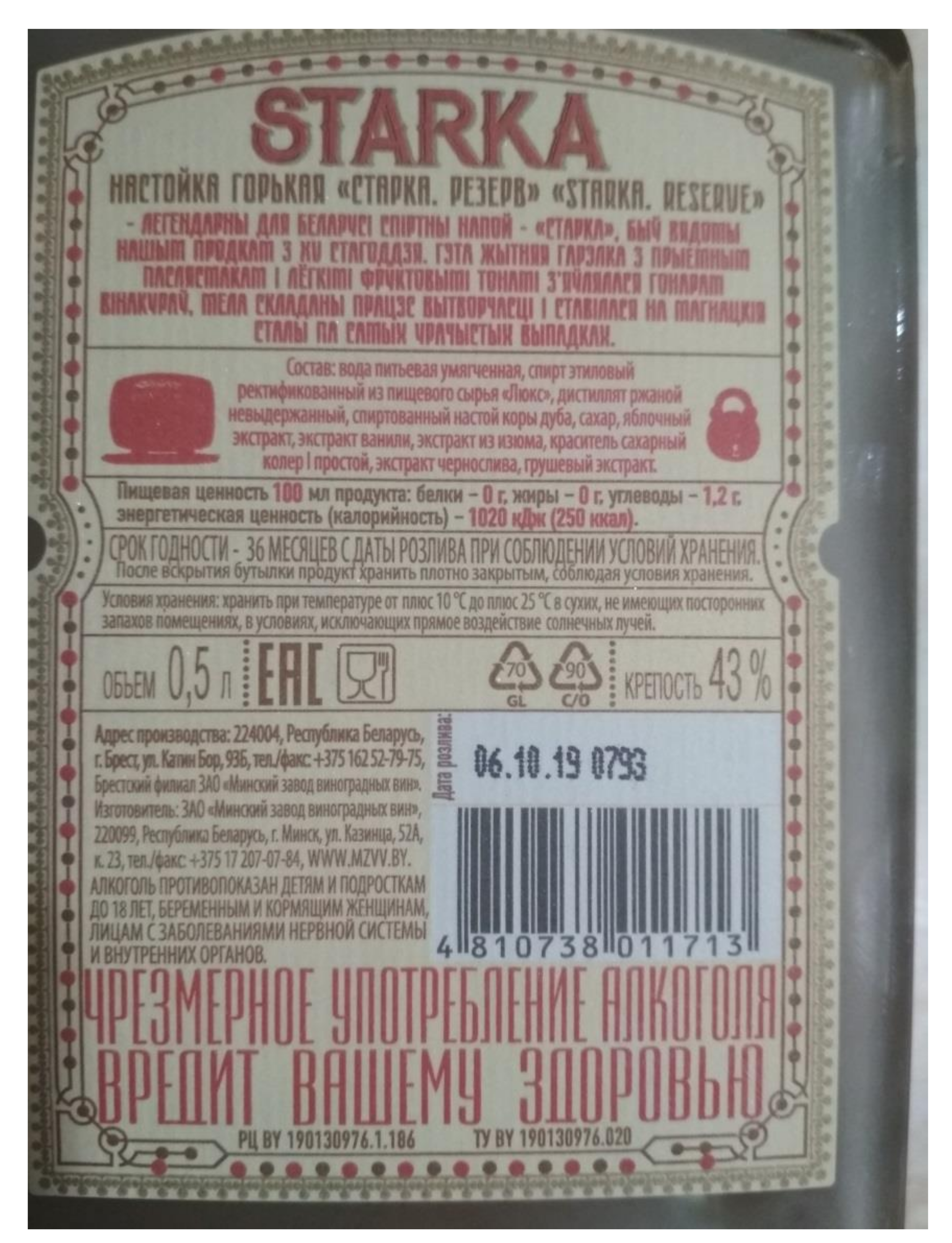
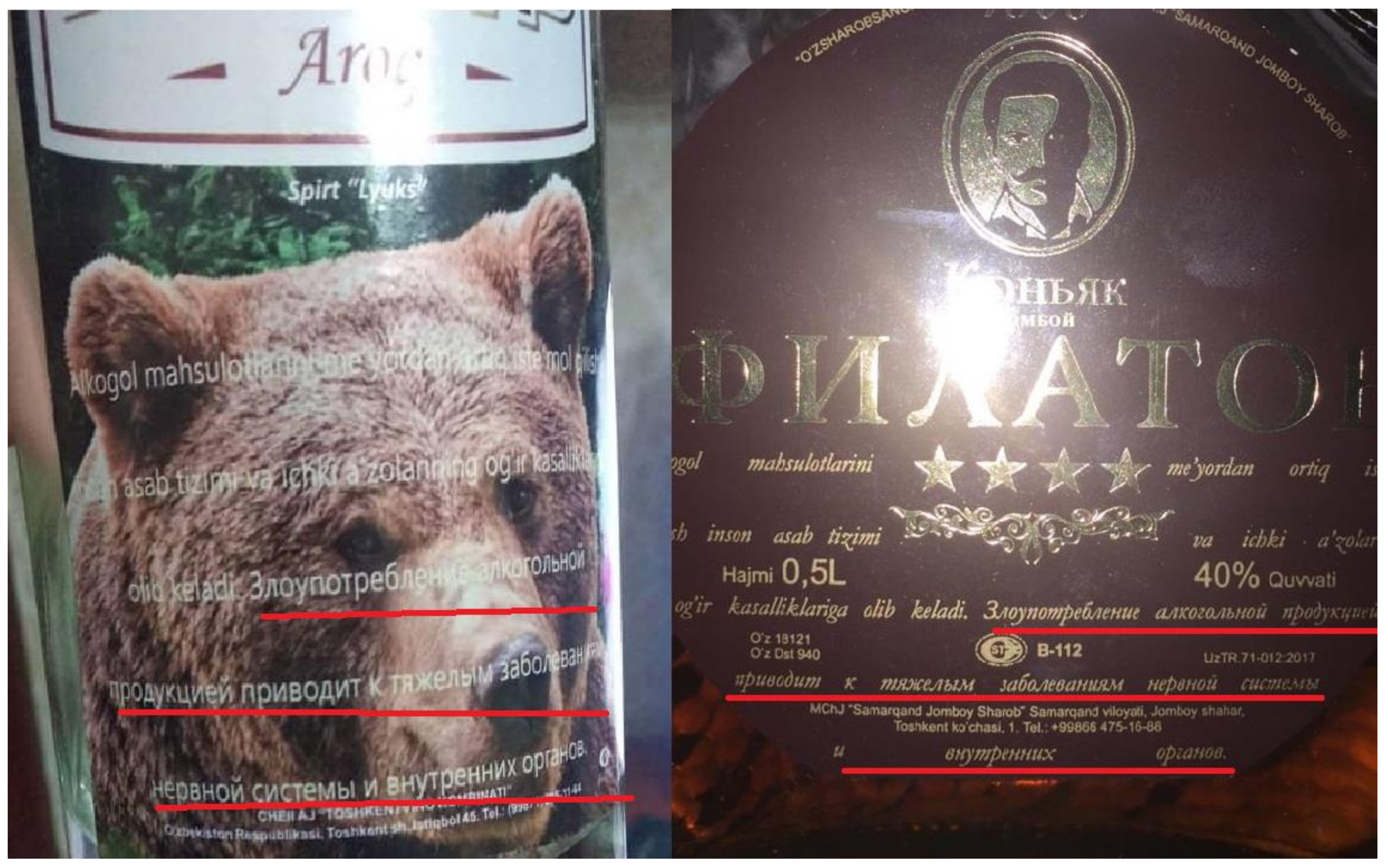
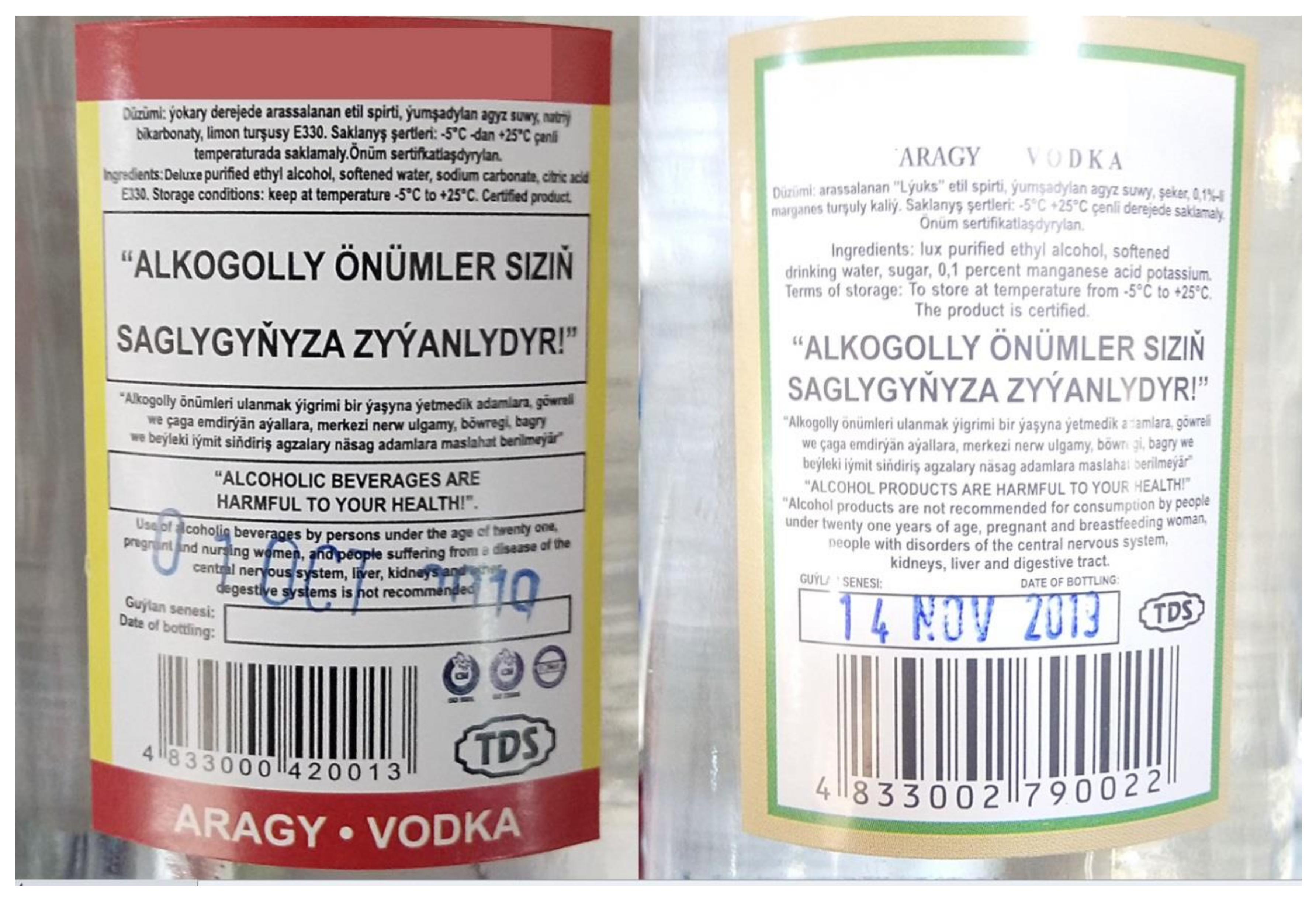
| Country | Health Warning(s) in Alcohol Advertisements | Health Warning(s) on Alcohol Containers | Exact Provision on Health Warnings and Related Regulatory Document(s) |
|---|---|---|---|
| Armenia* | No. | No. | - |
| Azerbaijan | Yes. Advertisements for alcoholic beverages with more than 5% alcohol by volume (ABV) must be accompanied by a warning about the harms regarding excessive consumption of the beverage to health. No specific content or form is defined. | No. Attempts to introduce pictorial health warnings were unsuccessful. | - |
| Belarus* | Yes. Advertisements for alcoholic beverages must be accompanied by the following health warning, in clear letters contrasting with the background, at the bottom of the advertisement and along its entire length, and occupy at least 10% of the advertising space: “Excessive alcohol consumption is harmful to your health.” | Yes. The same rules as for alcohol advertisements apply for the health warning: “Excessive alcohol consumption is harmful to your health.” Additionally, age and other consumption restrictions need to be featured, as follows: “Alcohol is contraindicated for children and youth under 18 years of age, pregnant and breastfeeding women, people with disorders of the central nervous system and internal organs.” | Health warnings and other information must be provided following additional technical regulations for beer, wine, and spirits. A recent letter from the Ministry of the Republic of Belarus “On the issue of placement on labels and in advertising of alcoholic beverages and beer phrases that alcohol consumption is harmful to health” from August 2019 states that health warnings are implemented in Belarus following national and international provisions. Source: [24]. |
| Kazakhstan* | Total ban on alcohol and tobacco (including electronic delivery systems and hookahs) advertising, including for trademarks and elements thereof. | Yes. All alcoholic beverages, except for beer, must feature information on the harms and contraindications of alcohol consumption, as follows: “Excessive alcohol consumption is harmful to your health. Alcohol is contraindicated for individuals under 21 years of age, pregnant and breastfeeding women, people with disorders of the central nervous system, kidneys, liver and digestive organs.” | Health information has to be provided in accordance with the Resolution No. 1081 “On approving the ‘Technical regulations on requirements for the safety of alcohol products’.” Source: [25]. This legislation was repealed in May 2019 since most of the producers were already following the EAEU regulations. |
| Kyrgyzstan* | Yes. Alcohol advertisements should be accompanied by text warnings containing information on the harms of alcohol consumption and the legal ban on the sale of alcohol to minors. Both messages must be featured in the same size and font size, and together they must occupy at least 10% of the advertising space. The color of the warning text should be in contrast to the color of the warning’s background. | No. Attempts to introduce pictorial health warnings and health warnings with at least 40% of the label’s size were unsuccessful. | - |
| Moldova | No. | Yes. A pictogram indicating that alcohol should not be used during pregnancy and a pictogram indicating that alcohol should only be used by people of 18 years and older. | The main law on alcohol, law No. 1100-XIV “About production and turnover of ethyl alcohol and alcoholic products,” imposes the rules on labeling. Source: [26]. |
| Russia* | Yes. Advertisements of alcoholic beverages must be accompanied by the following health warning, in clear letters contrasting with the background, at the bottom of the advertisement and along its entire length, and occupy at least 10% of the advertising space: “Excessive alcohol consumption is harmful to your health.” | Yes. Same rules as for the alcohol advertisements apply for the health warning: “Excessive alcohol consumption is harmful to your health.” Additionally, age and other consumption restrictions need to be featured: “Alcohol is contraindicated by children and youth under 18 years of age, pregnant and breastfeeding women, people with disorders of the central nervous system, kidneys, liver and digestive organs.” No size is specified by the ministry order. Attempts to introduce pictorial health warnings were unsuccessful. | The main law on alcohol, federal law No. 171, mandates the provide information on the “health harms of consuming alcoholic products” to consumers as part of the product labeling rules. The health warning is “communicated to consumers in the manner established by the Government of the Russian Federation.” The Order of the Ministry of Health and Social Development of the Russian Federation (Ministry of Health and Social Development of Russia) of 19 January 2007 N 49, Moscow “On the approval of a warning inscription on the consumer container of a unit of alcoholic beverages on contraindications to the use of alcoholic beverages” imposes the specific health warning. Source: [27]. |
| Tajikistan | Total ban on alcohol and tobacco advertising. | No. | - |
| Turkmenistan | Total ban on alcohol and tobacco advertising. | Yes. A health warning in black capital letters on a white background in bold, clear, easy-to-read font, occupying at least 20% of the size of the label for domestically produced alcoholic beverages. “Alcohol is harmful to your health!” Additionally, age and other consumption restrictions need to be featured: “Alcohol is contraindicated for individuals under 21 years of age, pregnant and breastfeeding women, people with disorders of the central nervous system, kidneys, liver and digestive organs.” | The main law that regulates alcohol, law No. 99-VI “On the prevention of the harmful effects of alcohol.” Source: [28]. |
| Uzbekistan | Total ban on alcohol and tobacco advertising. | Yes. A health warning with at least 40% of the size of the label in Uzbek and Russian. The following health warning has to be featured on the front label: “Alcohol abuse leads to severe diseases of internal organs and nervous system.” The legislation also allows for a graphical health warning. | The Annex to the Order of the Director-General of the Uzbek Agency for Standardization, Metrology and Certification dated 1 June 2016 No. 315 “Changes to the procedure for marking with the mark of conformity for alcoholic beverages produced by enterprises on the territory of the Republic of Uzbekistan” mandates “a medical warning occupying at least 40% of the label, in the form of a text and (or) a picture.” Source: [29]. |
| Health Warning(s) as Suggested in the First Draft Developed by the Russian Federation | Health Warning(s) as Suggested in the Draft and Disseminated by the World Trade Organization | Health Warning as Adopted in the Final Technical Regulation EAEU 047/2018 |
|
|
|
Publisher’s Note: MDPI stays neutral with regard to jurisdictional claims in published maps and institutional affiliations. |
© 2020 by the authors. Licensee MDPI, Basel, Switzerland. This article is an open access article distributed under the terms and conditions of the Creative Commons Attribution (CC BY) license (http://creativecommons.org/licenses/by/4.0/).
Share and Cite
Neufeld, M.; Ferreira-Borges, C.; Rehm, J. Implementing Health Warnings on Alcoholic Beverages: On the Leading Role of Countries of the Commonwealth of Independent States. Int. J. Environ. Res. Public Health 2020, 17, 8205. https://doi.org/10.3390/ijerph17218205
Neufeld M, Ferreira-Borges C, Rehm J. Implementing Health Warnings on Alcoholic Beverages: On the Leading Role of Countries of the Commonwealth of Independent States. International Journal of Environmental Research and Public Health. 2020; 17(21):8205. https://doi.org/10.3390/ijerph17218205
Chicago/Turabian StyleNeufeld, Maria, Carina Ferreira-Borges, and Jürgen Rehm. 2020. "Implementing Health Warnings on Alcoholic Beverages: On the Leading Role of Countries of the Commonwealth of Independent States" International Journal of Environmental Research and Public Health 17, no. 21: 8205. https://doi.org/10.3390/ijerph17218205
APA StyleNeufeld, M., Ferreira-Borges, C., & Rehm, J. (2020). Implementing Health Warnings on Alcoholic Beverages: On the Leading Role of Countries of the Commonwealth of Independent States. International Journal of Environmental Research and Public Health, 17(21), 8205. https://doi.org/10.3390/ijerph17218205





